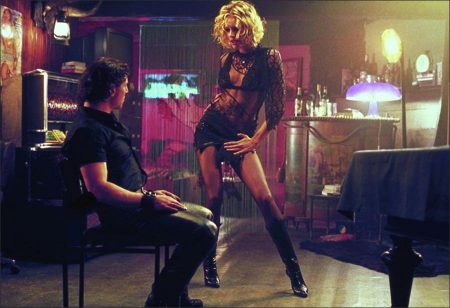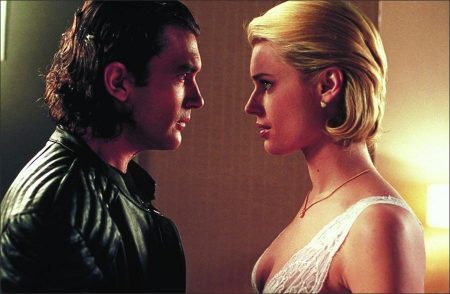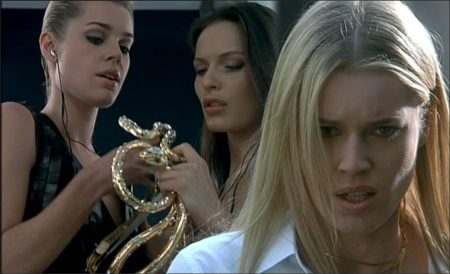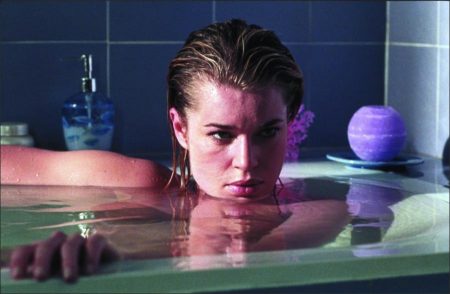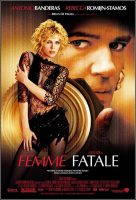Taglines: Nothing is more desirable or more deadly than a woman with a secret.
The thief Laurie Ash steals the expensive diamond jewel called ‘Eye of the Serpent’ in an audacious heist during an exhibition in Cannes 2001 Festival. She double-crosses her partners and is mistakenly taken as Lily, a woman who lost her husband and son in an accident and is missing since then, by an ordinary family. One day, while having bath in Lily’s bathtub, Lily comes back home and commits suicide. Laurie assumes definitely Lily’s identity, goes to America where she marries a rich man, who becomes the Ambassador of USA in France. When Laurie returns to France, her past haunts her.
Femme Fatale is a 2002 French erotic thriller/mystery film directed by Brian De Palma. The film stars Rebecca Romijn, Antonio Banderas, Peter Coyote, Eriq Ebouaney, Rie Rasmussen, Edouard Montoute, Thierry Frémont, Fiona Curzon, Daniel Milgram and Stéphane Petit. It was screened out of competition at the 2002 Cannes Film Festival.
Film Review for Femme Fatale
Brian De Palma, like Alfred Hitchock and Dario Argento, is always looking. So are his characters, and in the opening of his new film, Femme Fatale, Laure Ash (Rebecca Romijn-Stamos) watches Double Indemnity on French television. De Palma conceives for Romijn-Stamos a vixen made in Barbara Stanwyck’s image, only he remembers to give his creation a humane purpose.
For Laure, this is a spiritual act (one of many baptisms in the film), and for De Palma it’s a correction: he flips Billy Wilder the bird by saddling his femme fatale with a crisis that matters, even if her personal pain is not readily apparent when she and a group of thugs break into the Cannes Palais, hoping to swipe a fortune in diamonds from Regis Wargnier’s whorish girlfriend Veronica (Rie Rasmussen), with whom Laure makes out in a bathroom stall while Wargnier’s hideous East-West plays on the big screen.
Looks can be deceiving in De Palma’s films, especially in Femme Fatale, a work of pure aesthetic rapture whose sinuous camera movements are the stuff of dreams. The director’s remarkable use of water imagery welcomes Jungian readings, beckoning comparisons to Argento’s Trauma. Seven years after betraying her cohorts in crime, Laure returns to Paris a new woman—literally and figuratively—and married to an American ambassador (Peter Coyote).
De Palma is a master of signs: The Déjà Vue 2008 poster that decorates a telephone booth outside Nicolas Bardo’s (Antonio Banderas) apartment may seem like a simple wink to the audience, but the use of John Everett Millais’s “Ophelia” as cover art for the poster hints at Laure’s trouble with water. (In Trauma, and Argento upstart Chang Youn-hyun’s Tell Me Something, the Millais painting is used for similar stirring effect, suggesting dreams haunted by waking lives.)
Laure packs a gun and a one-liner or two, challenging the way men perceive women and using that awareness to devour and spit out her men. De Palma performs a triple whammy when he superimposes Romijn-Stamos’s face over that of the film’s many women (Stanwyck during the film’s opening shot and Mellais’s Ophelia when Laure chit chats with Nicolas over cold espresso): he acknowledges the character’s split self, reinforces the dreamlike impulsion of the narrative, and provides the sexist noir tropes of the past with another affront.
De Palma’s formal fixation with dualities is so pervasive the film takes on the texture of something to be deciphered—like a puzzle. (Always there’s a sense of the past looking forward into the present, and that any given move can forever change the shape of all things.) Even the dash that separates East from West in the title of Wagnier’s waterlogged film suggests a crisis, one between two very different worlds of thinking (and making movies).
De Palma has made remarkable use of split-screen before but never has it been so self-reflexively and personally deployed as it is in Femme Fatale. Nicolas is a washed-up paparazzo who comes to Paris hoping to reinvent himself, only he discovers that he has nothing to photograph but the church plaza across the street from his apartment, and the collage he creates on the walls of his apartment represents his ongoing struggle to reinvent himself. It is clear that Nicolas is meant as a proxy for De Palma, only the director’s struggle is an attempt to tease, update, and correct the noir tropes of the past. But for both Nicholas and De Palma, Romijn-Stamos becomes the holy vessel through which they realize divine moments.
Continue reading and View the trailer.
Femme Fatale (2002)
Directed by: Brian De Palma
Starring: Rebecca Romijn, Antonio Banderas, Peter Coyote, Eriq Ebouaney, Rie Rasmussen, Edouard Montoute, Thierry Frémont, Fiona Curzon, Daniel Milgram, Stéphane Petit
Screenplay by: Brian De Palma
Production Design by: Anne Pritchard
Cinematography by: Thierry Arbogast
Film Editing by: Bill Pankow
Costume Design by: Olivier Bériot
Set Decoration by: Françoise Benoît-Fresco
Art Direction by: Denis Renault
Music by: Ryuichi Sakamoto
MPAA Rating: R for strong sexuality, violence and language.
Distributed by: Warner Bros. Pictures
Release Date: November 6, 2002
Visits: 340
